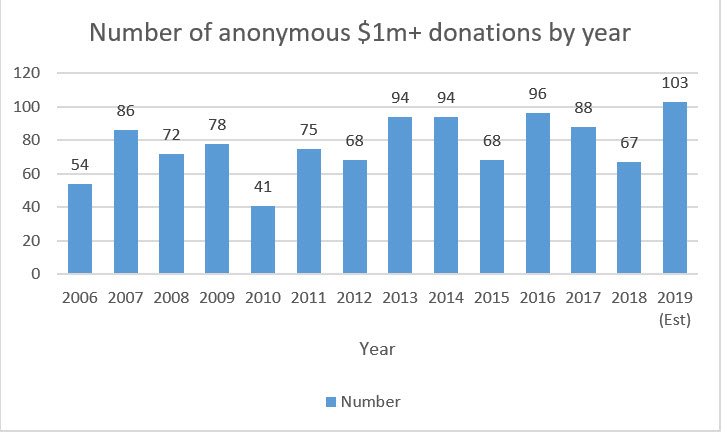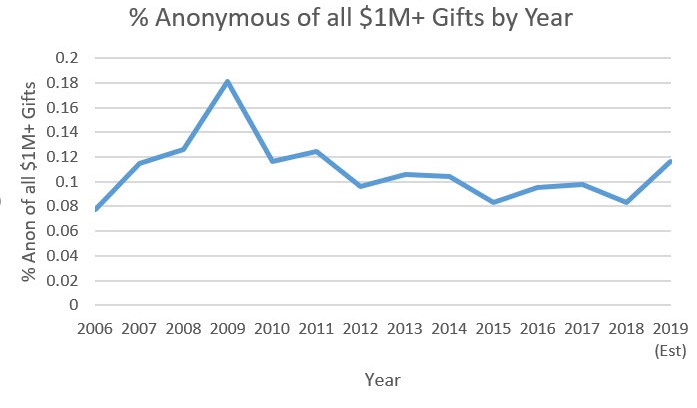
Image by Pete Linforth from Pixabay
It used to be that anonymous donors were relatively rare. When I started my career, you’d see maybe two or three anonymous donors on any given annual honor roll of donors.
Now there are a growing number of opportunities for donors to hide in plain sight in addition to just a listing as “Anonymous,” and I’m wondering if the appeal of LLCs and donor advised funds (DAFs) and other vehicles-to-come will become even more attractive to a particular kind of donor.
Let’s say, for example, that you are a philanthropically-minded (yet very minor) member of a dynasty with a less-than-stellar public reputation. Or a member of a polarizing family or profession. A junior Sackler, say. A pot-shop millionaire. Tiffany Trump. Some nonprofits might welcome your money, but others might be uneasy with forging a relationship. You cause due-diligence alarm bells to go off. It’s awkward.
You have causes you want to support, but the causes don’t want your support. What do you do?
Well, you could make an anonymous donation via a DAF or LLC. You’d get the tax deduction, the nonprofit is blissfully ignorant of your identity and free of any pesky ethical/due diligence concerns (I’m playing devils’ advocate here, don’t @ me), and all you’re missing out on is the naming-rights glory which, given the circumstances, is publicity you don’t need right now anyway.
Or maybe you just want to give your tens of millions in peace. Announcing that you’re wiping out the student loan debt for a whole graduating class or signing the Giving Pledge invites too many hecklers yelling that you shouldn’t have made your money that way or that your personal and political beliefs are too self-serving or that you’re not giving to the right things. You’ve got some eloquent support, but giving anonymously is looking pretty attractive, right?
Giving USA and others do a great job of tracking trends of donations to specific causes, but I started to wonder if think tanks, consultants and/or nonprofits are starting to track what percentage of major donations annually are anonymous, and what percentage of total giving that represents. Is it increasing? Staying the same? Are certain (types of) donors more frequently opting for anonymity?
Depending on the answers, how might that data impact how a nonprofit approaches high-visibility (or highly risky) prospects?
I contacted my colleague Dan Lowman, senior vice president of the Survey Lab at GG+A, to see if they have been tracking any data on the subject and luckily, they had helpful information about $1M+ gifts from across the non-profit sector.
As you can see, it’s been a pretty bumpy ride over the past 13 years, but the trajectory of anonymous donations above $1 million is on the rise. We’re less than halfway through 2019 with only 43 anonymous gifts of $1m+ so far, but if the pace holds true to its acceleration, the Survey Lab projects an all-time high for anonymous gifts this year.
As a percentage of all $1m+ donations, anonymous giving this year could outpace each of the past seven years by a mile.
That bump in anonymous giving at the heart of the Great Recession is an interesting spike, isn’t it? Was that a time when philanthropically-minded individuals didn’t want to flaunt the fact that they were conspicuously wealthy? Or something else?
With income inequality on the minds of many, and intense public scrutiny of wealthy donors by philanthropy-watchers increasing, are we about to see another spike in anonymous giving? Will it be a blip or part of an on-going trend? I think it will take another two or three years for us to know for sure, but I for one am going to be watching with great interest.
FOR FURTHER CONSIDERATION
In this article, Vox.com’s Dylan Matthews interviews Phil Buchanan, president of the Center for Effective Philanthropy.
From the article:
Stepping way back, for the last 18 years in this job I’ve felt like philanthropy and the nonprofit sector it supports often get taken for granted. I think we undervalue the role of this sector, particularly in our country, and I think much of the narrative has been, “Philanthropy and nonprofits are broken and business thinking has the answer.”
And now we have a new critique, which is more from the left politically, from folks like Anand [Giridharadas] and others, which is, “No, actually, philanthropy is just an anti-democratic force or a ruse to distract from evil-doing. Actually, government has the answer.”
I actually think that nobody’s got all the answers. I think it’s particularly concerning right now because there’s some evidence that giving levels may be plateauing. It’s hard to tell for sure because we’re all waiting on the Giving USA data [the gold standard dataset on charitable giving]. And while I think we should be really critical of stupid or ineffective philanthropy, we should hold up giving as a value and recognize that when done well, it can have tremendous positive impact.”


